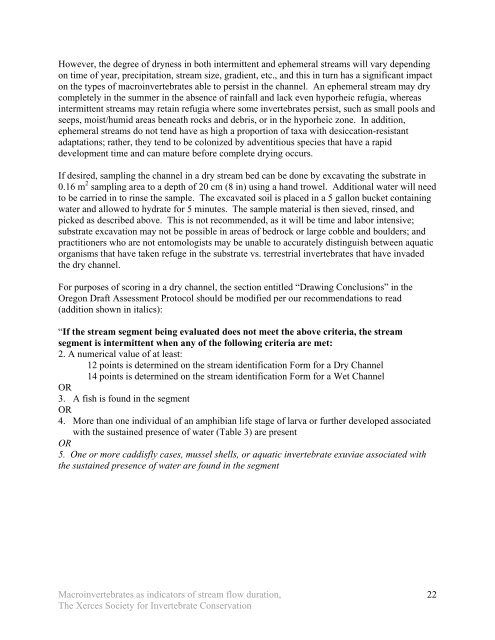Using Aquatic Macroinvertebrates as Indicators of Stream Flow ...
Using Aquatic Macroinvertebrates as Indicators of Stream Flow ...
Using Aquatic Macroinvertebrates as Indicators of Stream Flow ...
Create successful ePaper yourself
Turn your PDF publications into a flip-book with our unique Google optimized e-Paper software.
However, the degree <strong>of</strong> dryness in both intermittent and ephemeral streams will vary dependingon time <strong>of</strong> year, precipitation, stream size, gradient, etc., and this in turn h<strong>as</strong> a significant impacton the types <strong>of</strong> macroinvertebrates able to persist in the channel. An ephemeral stream may drycompletely in the summer in the absence <strong>of</strong> rainfall and lack even hyporheic refugia, where<strong>as</strong>intermittent streams may retain refugia where some invertebrates persist, such <strong>as</strong> small pools andseeps, moist/humid are<strong>as</strong> beneath rocks and debris, or in the hyporheic zone. In addition,ephemeral streams do not tend have <strong>as</strong> high a proportion <strong>of</strong> taxa with desiccation-resistantadaptations; rather, they tend to be colonized by adventitious species that have a rapiddevelopment time and can mature before complete drying occurs.If desired, sampling the channel in a dry stream bed can be done by excavating the substrate in0.16 m 2 sampling area to a depth <strong>of</strong> 20 cm (8 in) using a hand trowel. Additional water will needto be carried in to rinse the sample. The excavated soil is placed in a 5 gallon bucket containingwater and allowed to hydrate for 5 minutes. The sample material is then sieved, rinsed, andpicked <strong>as</strong> described above. This is not recommended, <strong>as</strong> it will be time and labor intensive;substrate excavation may not be possible in are<strong>as</strong> <strong>of</strong> bedrock or large cobble and boulders; andpractitioners who are not entomologists may be unable to accurately distinguish between aquaticorganisms that have taken refuge in the substrate vs. terrestrial invertebrates that have invadedthe dry channel.For purposes <strong>of</strong> scoring in a dry channel, the section entitled “Drawing Conclusions” in theOregon Draft Assessment Protocol should be modified per our recommendations to read(addition shown in italics):“If the stream segment being evaluated does not meet the above criteria, the streamsegment is intermittent when any <strong>of</strong> the following criteria are met:2. A numerical value <strong>of</strong> at le<strong>as</strong>t:12 points is determined on the stream identification Form for a Dry Channel14 points is determined on the stream identification Form for a Wet ChannelOR3. A fish is found in the segmentOR4. More than one individual <strong>of</strong> an amphibian life stage <strong>of</strong> larva or further developed <strong>as</strong>sociatedwith the sustained presence <strong>of</strong> water (Table 3) are presentOR5. One or more caddisfly c<strong>as</strong>es, mussel shells, or aquatic invertebrate exuviae <strong>as</strong>sociated withthe sustained presence <strong>of</strong> water are found in the segment<strong>Macroinvertebrates</strong> <strong>as</strong> indicators <strong>of</strong> stream flow duration,The Xerces Society for Invertebrate Conservation22
















